Depending on where you live, you may have experienced a delicious fruit known as rambutan. Rambutan is native to Southeast Asia although it has become popular in other regions. The outer appearance of this strange-looking fruit is the first thing that makes it stand out, but it has many other unique features as well.
A rambutan is an exotic tropical fruit that tastes like a mix between a strawberry and a grape. While lychee and rambutans are often compared, there are many differences between them from their outer appearance to their distinct flavors.
If you can’t find fresh rambutan near you, you can probably find it dried or canned. This tasty exotic fruit is definitely worth trying if you can find it! Keep reading to find out more about this tropical fruit and what makes it stand out from other types of fruit.

One of the most interesting parts of rambutan is its outer appearance.
©Bigc Studio/Shutterstock.com
What Is Rambutan?
If you’ve ever seen a rambutan, you might think it looks like it comes from another planet. As bizarre as it looks on the outside, you’ll find some familiar flavors when you bite into it. Rambutan is a tropical fruit that is often compared to a grape or a strawberry due to its sweet and slightly tangy flavor.
One of the key distinguishing factors between rambutan and other types of fruit is its outer appearance. Normally red and green, rambutan looks like a hairy version of a strawberry. The outside of rambutan has long, soft spikes that make it easy to tell it apart from other fruit.
If you can find it in your local grocery store or farmer’s market, you can eat rambutan fresh, but it is tricky to find in most states. You’ll notice when you peel open the center of the fruit, the inside looks strikingly similar to the lychee fruit, even though rambutan is a bit creamier. Aside from the similarity to a grape or strawberry, the flavor is sometimes compared to a pear or cherry as well.
Rambutan isn’t just tasty—there are also numerous benefits to eating this fruit. Let’s take a closer look at the benefits of eating rambutan as well as how to eat it.
Benefits of Eating Rambutan
No matter how you choose to enjoy it, rambutan can be beneficial for your health in many ways. Rambutan isn’t always easy to find, but it’s worth looking for because of its sweet flavor and health benefits. Here are some of the benefits of eating this exotic fruit:
Great for Your Digestive Health
Most fruits benefit your digestive health in some way and rambutan is no different. The fiber is part of what makes it beneficial for your digestive health and rambutan has both soluble and insoluble fiber.
The insoluble fiber passes through your digestive system undigested, which can help prevent digestive issues such as constipation. The soluble fiber also has many benefits, especially when it comes to your gut health. Soluble fiber can feed the healthy bacteria in your gut and even help to stabilize your blood sugar levels.
Low in Calories
While some fruits, like bananas, are higher in calories and can contribute to weight gain, rambutan is a lower-calorie fruit. Around 100 grams of it has less than 80 calories.
This can make it a great snack for those who are trying to lose weight or maintain their current weight.
Rich in Vitamins and Minerals
Rambutan is also beneficial for your health due to the amount of vitamins and minerals it contains. This fruit is rich in fiber, vitamin C, and copper. It also contains smaller amounts of potassium, phosphorus, and magnesium.
When you eat rambutan, you’ll likely eat more than one considering the size of the fruit. One serving, or one cup, has about 10% of your daily value of copper and manganese.

Although the inside of lychee and rambutan look similar, their exteriors are very different.
©Bigc Studio/Shutterstock.com
Rambutan vs. Lychee Fruit
If you’re familiar with rambutan, you might wonder how it compares to lychee. Lychee is another type of exotic fruit that’s also native to Southeast Asia. These two fruits are often confused and while they do share some qualities, there are many differences between them as well.
One of the differences between rambutan and lychee is their distinct outer appearances. Lychee doesn't have the flexible spikes rambutan has. Instead, lychee looks more like a rough and bumpy strawberry or raspberry.
Although rambutan and lychee do have similar flavors, rambutan is sweeter than lychee. Lychee also has slightly fewer calories although they’re both considered low-calorie fruits. There’s no major difference in their nutritional values and they both contain many nutrients.
How to Eat Rambutan
Considering their strange outer appearance, it’s clear that you can’t eat the outside of rambutan, but how do you eat this fruit? When you eat an exotic fruit for the first time, it’s not always easy to determine how to eat it.
It’s difficult to find it fresh in most states, but if you do have the chance to eat rambutan fresh, you should first determine whether the fruit is ripe or not. You can tell the fruit is ripe when the outside of it, including the spikes, are mostly red. The spikes will often be a greener color when they’re not ready to be eaten.
If the rambutan is ripe, you can eat the fresh fruit by slicing the peel with a knife and peeling it back to reveal the flesh inside the fruit.
The inside of the fruit does contain a large seed in the middle which can’t be eaten. You can either eat the outside of the flesh and spit the seed out, or you can cut the fruit in half and pull the seed out before you eat it.
Where Can You Purchase Rambutan?
If you live in the United States, you’ve likely never seen fresh rambutan in the store although it does grow in certain warm climates. This fruit, along with lychee, is an exotic tropical fruit that’s native to certain regions in Asia.
Check the local grocery stores or farmer’s markets near you if you’re looking to purchase fresh rambutan. However, if you’re interested in trying this fruit, you can typically purchase it dried or canned. If you can’t find rambutan in your local grocery store, look for it in an Asian market or you can purchase it online.
Eating Rambutan: Final Thoughts
Rambutan is a delicious fruit with many health benefits. This sweet fruit tastes like a combination of a grape, strawberry, or even a pear, depending on where you get it from.
If you can find this exotic fruit near you, it’s worth trying it fresh! If not, try to find a dried or canned version you can use in various recipes to enjoy the flavor and benefits of rambutan.
Recipe Card
Whether you enjoy rambutan on its own or in a recipe, this fruit is both delicious and nutritious. Try this tasty recipe out:
Print
Rambutan and Shrimp Salad with Citrus Vinaigrette
- Total Time: 25 minutes
Ingredients
- 1 lb large shrimp, peeled and deveined
- 2 cups fresh rambutan, peeled and halved
- 6 cups mixed salad greens (e.g., arugula, spinach, and watercress)
- 1 cup cherry tomatoes, halved
- 1 cucumber, thinly sliced
- 1/2 red onion, thinly sliced
- 1/4 cup chopped fresh cilantro
- 1/4 cup chopped fresh mint
- 1/4 cup crumbled feta cheese (optional)
For the Citrus Vinaigrette:
- 1/4 cup olive oil
- 2 Tablespoons fresh orange juice
- 1 Tablespoon fresh lime juice
- 1 Tablespoon honey
- 1 teaspoon Dijon mustard
- Salt and pepper to taste
Instructions
In a large pot of boiling salted water, cook the shrimp for 2-3 minutes until they turn pink and opaque. Drain and let them cool.
In a large salad bowl, combine the salad greens, cherry tomatoes, cucumber, red onion, fresh cilantro, and fresh mint.
Add the peeled and halved rambutan to the salad.
In a small bowl, whisk together olive oil, fresh orange juice, fresh lime juice, honey, Dijon mustard, salt, and pepper to make the Citrus Vinaigrette.
Add the cooked and cooled shrimp to the salad.
Drizzle the vinaigrette over the salad and toss gently to coat.
If desired, sprinkle crumbled feta cheese on top.
Serve immediately and enjoy
Nutrition
- Calories: 320
- Sugar: 16 g
- Sodium: 400 mg
- Fat: 18 g
- Carbohydrates: 25 g
- Fiber: 4 g
- Protein: 20 g
- Cholesterol: 150 mg
The image featured at the top of this post is ©leonov.o/Shutterstock.com

